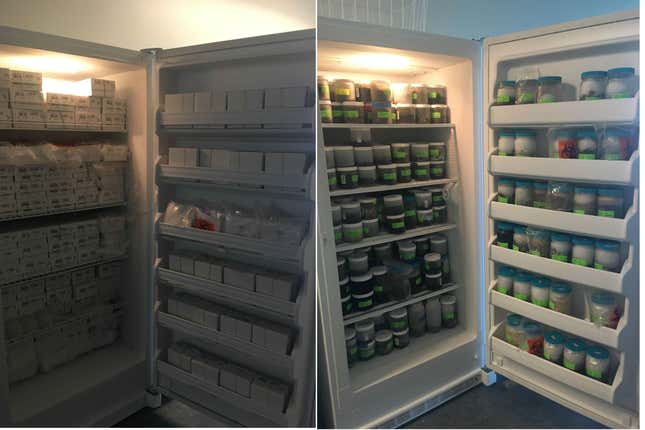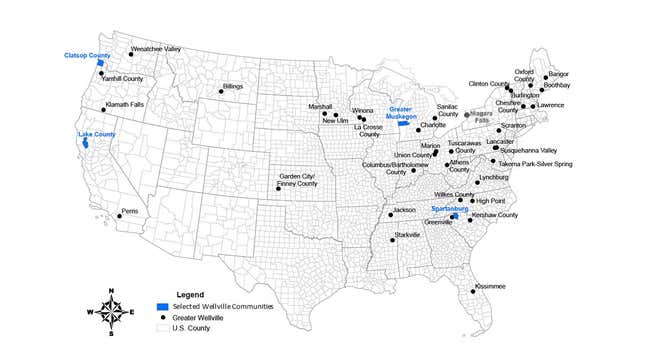In the freezers of Arizona State University’s Human Health Observatory (H2O) lab are rows upon rows of jars, some white, some translucent with black chunks of solid inside. Together they hold something you would not want anywhere near the inside of your icebox: The biggest collection of sewage sludge in the US.
Every month, dozens of new samples arrive in boxes from across the country, joining over 1,000 jars already stored under freezing temperatures. It’s part of a novel effort by ASU Biodesign Center for Environmental Security scientists who believe you can tell the health of a community by looking at its sewers and tapping into the wealth of information stored in human waste.
Measuring the impacts of public health interventions like anti-smoking or anti-drug campaigns used to involve a cumbersome process of distributing surveys and rounding up representatives to be tested. But by testing wastewater for telling indicators of human behaviors, researchers can derive anonymized, aggregated information about how healthy a community is—without having to test everyone.
“How do you know that people are eating more fruits, how do you know if they’re exercising more? How do you measure those things?” says Joshua Steele, a postdoctoral student who works in the lab. “We can get those concrete metrics because no matter where you are and what you’re doing, you have to use the wastewater system.”
Nearly everything that we consume ends up in our sewers in one form or another. Scientists have been able to figure out illegal drug use by directly testing sewage water for cocaine and opioids. Pharmaceuticals, ranging from discarded prescription drugs to lotions that we rub on our bodies (and rub off in the shower), have been found in wastewater in the past decade or so. These can tell us all sorts of things. For example, by looking at levels of antibiotics or antihistamines, you can tell what ailment a community is suffering from. Christine Vatovec, a professor at University of Vermont, recently found that in spring when the air is filled with pollen, antihistamine levels shoot up in the Burlington, Vermont treatment plant. When college students leave town, antivirals levels in the water fall and ulcer medications go up.
The rise of industrialization and commercial agriculture, along with advancements in medical treatments, spurred concerns about the persistence of chemicals in the environment in the 1990s. But understanding exactly what was going on was a challenge, because many of the emerging contaminants were present in levels so minute that researchers couldn’t accurately test for them. But analytical methods have improved considerably, and that’s changing the entire field of study.
But with better technology like the liquid chromatography-tandem mass spectrometry and rising awareness about the presence of chemicals in drinking water, the dark and dingy sewers are increasingly put under the spotlight.

Scientists in the ASU lab can now isolate “biomarkers” in waste that can measure a particular human habit—positive behaviors like exercising or negatives ones like drinking alcohol or smoking cigarettes. For example, nicotine usually degrades into cotinine and 3-hydroxycotinine, unique compounds that scientists can look for in wastewater. By analyzing the levels of hormones like cortisol and other glucocorticoids, they can tell how stressed people are or how much they’ve been exercising.
“The nice thing is that we can collect it on an aggregate basis so we it’s not an invasion of privacy,” says Steele. “At a community level, we can gauge a measure, we can feel the heartbeat of a community and track these different signals.”
In the fall of 2014, the nonprofit group HICCup launched a nationwide community health competition called “The Way to Wellville.” Five communities were picked to participate in a five-year competition to improve their health, including tackling obesity, substance abuse, and mental health. But for the competition to be effective, the organizers needed an unbiased and reliable method of measuring the efficacy of the community campaigns and interventions. Rolf Halden, director of the H2O lab, approached the group to offer their services.

Several communities signed up. Every month since March 2015, they’ve sent their wastewater samples to the lab for testing, and at the end of the year they will get an annual report. The criteria for testing depends on the biomarkers they’re interested in, but a range of chemicals—including antibiotics, opioids such as morphine and oxycodone, hormones, and caffeine—have been discussed.
“Just testing the sewage is not going to actually change the community’s health,” says Steele, but if they can track changes in the chemicals over time, “they can learn what kinds of programs are effective.”
The H2O lab is also looking at sewage flowing out of the ASU campus, tracking indicators for alcohol intake and smoking rates. These data can be valuable signposts about student health and effectiveness of rule enforcement, since ASU is a dry and non-smoking campus.
Peering into the sewers to monitor and improve public health isn’t a new idea. The Environmental Protection Agency collected sewage sludges, which are byproducts of wastewater treatment, from 164 wastewater treatment plants across the country in 2001 and 2006 to detect the presence of emerging contaminants like flame retardants, hormones, and antibiotics. Around 50 percent of sewage sludge produced annually is reused as soil—which means these persistent chemicals may runoff into rivers. The EPA wanted to determine which of these contaminants should be regulated under the Clean Water Act.
They found a variety of flame retardants, pharmaceuticals, and personal care products in the samples. While no new regulations emerged from the discovery of these chemicals, EPA is continuing to evaluate emerging contaminants in public water systems. Meanwhile, the EPA’s samples—chunks of dry, soil-like substances—have been added to the national sewage sludge repository within the H2O.
There are other related investigations currently underway. MIT’s Underworlds project, which launched in 2015, sends robots underground to detect the presence of viruses and biomarkers for illnesses such as diabetes in the sewers around Boston.The goal is to spot epidemics before they happen. According to MIT, they are also interested in collecting data on pharmaceuticals in the water, to see if medication use spikes at certain times of the year. They’ve detected traces of ibuprofen and acetaminophen so far, but haven’t come to any clear conclusions about trends in drug use.
What may be unique about the H2O’s research efforts is that they will focus on specific communities over a period of time and provide feedback to local policymakers. The focus on real world application also extends beyond the Wellville competition: The center also operates a nonprofit fee-for-service mass spectrometry facility in its labs for any interested community. They can contact the center to get their wastewater analyzed for a fee that starts at $50 per sample.
“I really enjoy the idea of giving information to a population to help them see on their own where they need to work on,” says Steele. “When you read about a chemical in the news you don’t really know much about it, but when you see ‘Oh, this is my own sewage, this is my own urine,’ this becomes a personal thing.”
As for the first question everyone asks, the answer is no. All the samples are frozen, and the lab smells normal, not a public bathroom. There also aren’t visible clumps of feces in the wastewater samples because it is filtered beforehand. “But when we melt them to test they do smell a little bit,” Steele says. ‘But that’s part of what we signed up for.”
